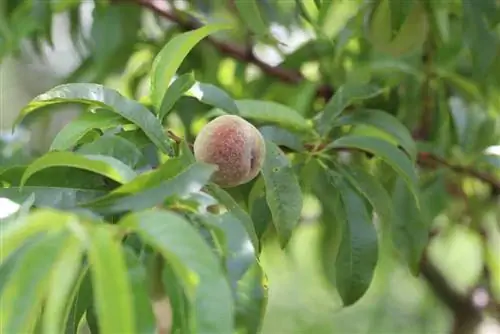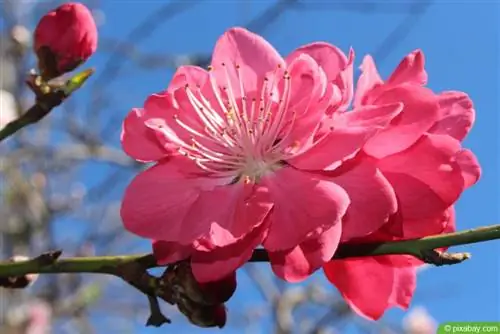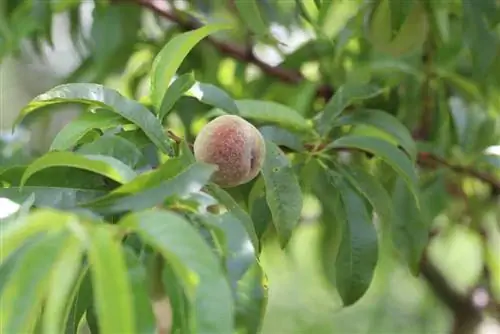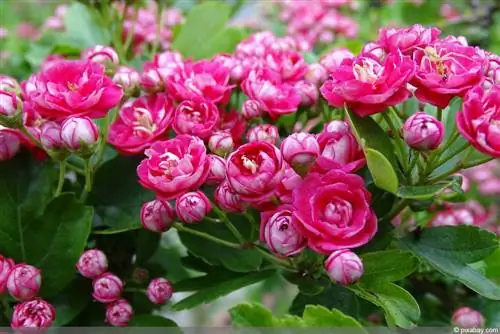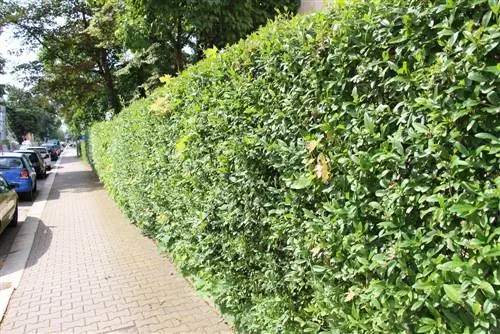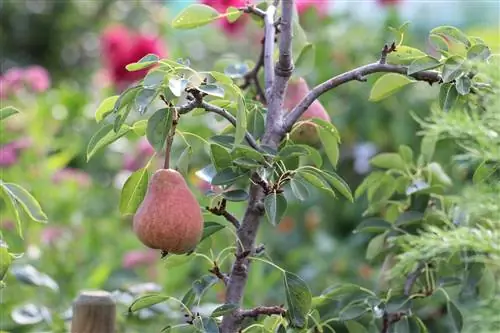- Author admin [email protected].
- Public 2023-12-17 03:39.
- Last modified 2025-01-24 12:45.
Tasty home-grown peaches are also possible in a container if there is no garden available for a tree. However, keeping it in a pot is different to a tree grown outdoors. Correct pruning is also important in order to get a rich harvest every year, even from a relatively small peach tree. The correct care for cultivation in the bucket is explained below and the correct cutting instructions are given.
potted fruit
Various types of fruit are already available in stores specifically for cultivation in buckets. This also includes the tasty peaches. These trees are bred to remain small and not require as much space, but still provide delicious fruit. It is recommended to buy these weak-growing trees for containers commercially, because a peach tree bred for the garden would wither in the container, not bloom and therefore not bear fruit.
Cutting instructions
To ensure that the peach tree grown in the pot produces a productive harvest every year, correct pruning is important. Peaches only bear fruit on annual wood. This means that the fruits form on the shoots from the previous year. Each shoot only lasts for one year. From the third year onwards, no more buds and only a few leaves are formed. Therefore, the ideal cut for a rich harvest should look like this:
- cut back consistently every year
- Use garden or pruning shears
- always disinfected and sharp
- in the spring before budding
- or immediately after harvest in late summer
- cut three quarters of the harvested shoots
- shorten the remaining ones to three eyes
- here the new shoots for new fruits are formed
- Make sure the lighting is even
- Remove any woody shoots that no longer bear fruit
Tip:
If the peach tree is not cut for several years, the new shoots for the fruit become shorter and shorter and the peaches only grow in the outer crown of the tree. It is therefore important to maintain the balance of new and old shoots during an annual cut.
Real and fake shoots
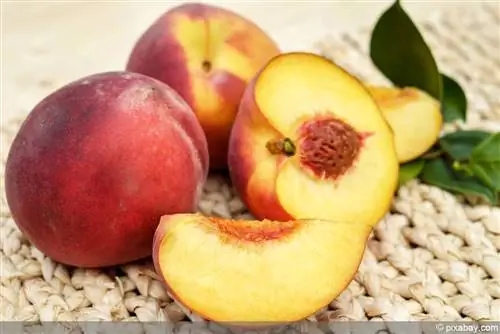
The peach tree has a special feature because it forms real and fake shoots, which must be kept apart for cutting. These are also called the false and true fruit shoots. When cutting, these two types of shoots must be kept apart, otherwise the tree will not bear fruit the following summer. The shoots can be distinguished as follows:
- true fruit shoots bear roundish flower buds
- always combined with one or two leaf buds
- fruit will form here later
- must be preserved
- only leaf buds at the top of the shoot
- can be removed
- false fruit shoots also have flower buds
- but these are not surrounded by leaf buds
- can therefore be removed completely
So it is important to look very carefully when making a cut. But this is easier to recognize, especially with small peach trees grown in pots, than with a large tree in the garden.
Tip:
The false fruit shoots also bear fruit first, but these are shed as the year progresses. This is because the peaches feed on leaves. However, these leaves are missing on the false fruit shoots in the immediate vicinity of the fruit.
Cutting wrong fruit shoots
So that the false fruit shoots do not get out of hand and true fruit shoots can form from them next year, they must be cut. You should proceed as follows:
- cut false fruit shoots back to the trunk
- alternatively shorten to short stubs
- There should be one or two leaf buds here
- These produce real fruit shoots throughout the year
- wear peaches next year
Cultivation in a bucket
If the peach tree is cultivated in a pot, the roots of the tree need enough space here. Therefore, the vessel must be chosen so large that there is enough space around the circumference and also at the bottom. However, a 25 liter container should be sufficient. Because there is only limited space, the care for the peach tree also changes, which is different than the care for trees in the garden. Cutting, fertilizing and watering as well as wintering are handled differently here.
Substrate
The substrate for the peach tree cultivated in a container should be loose, permeable, fresh and nutrient-rich. Even when planted in a container, the tree develops its beautiful flowers and produces a rich harvest of tasty fruits in summer. The soil used should be chosen as follows:
- Garden soil
- with compost, sand and peat
- potting soil from stores
Ready-made potting soil has the advantage that it contains the nutrients that the peach tree needs for the first year. It is important to make sure that the soil you buy contains potassium and nitrogen.
Tip:
It is recommended that peach trees grown outdoors are not fertilized in the first year. With potted plants, however, things are different; fertilizing can start after about three months. Because the nutrients in the bucket are washed out more quickly when watered.
Plants
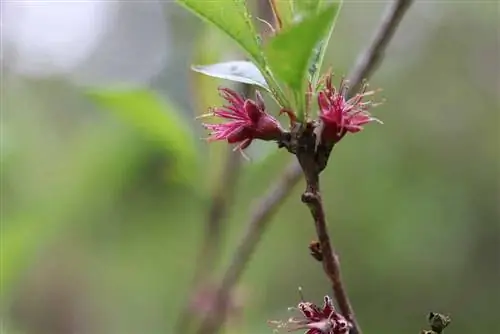
After the right pot has been selected, it must be prepared for the peach tree. To prevent waterlogging, ideally a drainage system should be installed over the drain hole. To do this, first fill the pot shards or gravel into the bucket and place a plant fleece over it. Only then is some of the prepared soil filled in. Then proceed as follows when planting the peach tree:
- Dip tree with bale briefly into water
- then insert
- fill in remaining soil
- press well
- pour on
Location
The location for the peach tree cultivated in a container should be sunny and bright. However, direct midday sun should be avoided in the summer months. A light-colored wall behind the plant reflects the sun, which can cause heat to build up on the tree. The ideal locations for the peach tree in the pot look like this:
- in a corner of the balcony or terrace
- Ideally covered
- still airy
- moisture should not build up
Tip:
If you want to give your balcony or terrace a Mediterranean look with the peach tree, you can also paint a corner in a different color. It looks nice when the wall looks as if the plaster has fallen off and bricks are showing through.
Watering and fertilizing
A peach tree grown in a container requires significantly more water and fertilizer than a tree planted in the garden. This is the only way to ensure that the peach receives enough nutrients and water, because the plant cannot supply itself in a closed container. Therefore, care should continue as follows:
- water regularly
- especially on hot days
- Use rainwater
- water regularly in the pot even in winter
- fertilize every two to three weeks
- Fertilizer should also contain potassium and nitrogen
- special commercial fruit tree fertilizer recommended
- stop fertilization after harvest
Repotting
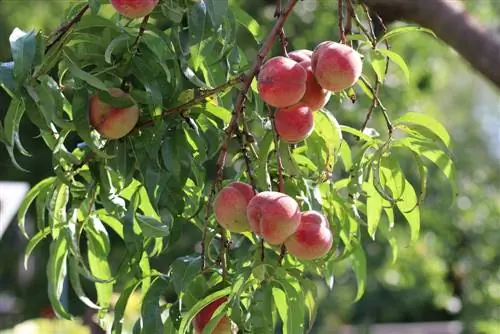
Once the peach tree has been planted in the ground, further digging should generally be avoided. Therefore, the plant should only be repotted if the pot has become much too small. It is better to choose a larger container right from the start, even if this should actually be avoided for many plants. To ensure that the peach still receives fresh substrate, the top layer of soil is carefully removed and fresh substrate is added.
Wintering
Peach trees are not hardy and can be damaged by frost. Because they are not used to the strong frosty nights in our latitudes. The peach tree cultivated in a bucket can be overwintered well in a frost-free and protected, cool room. A cool basement, a stairwell or even the garage are ideal for this. If the bucket is to remain on the balcony or terrace in winter, you should proceed as follows:
- Place the bucket on a wooden or polystyrene plate
- Wrap the container with plant fleece
- alternatively use brushwood plates
- Mulch the soil thickly
- Also cover the tree with plant fleece
- water on frost-free days
- do not fertilize
- Don’t start fertilizing until late winter
- unpacking the tree on warm spring days
- continue protection on cold nights
Tip:
A shelter can also be built from wooden slats and plant fleece into which the bucket with the peach tree can be pushed over the winter. This means it is protected all around. If the fleece is not firmly connected to the wood on one side, the shelter can be opened at any time if necessary.
Diseases
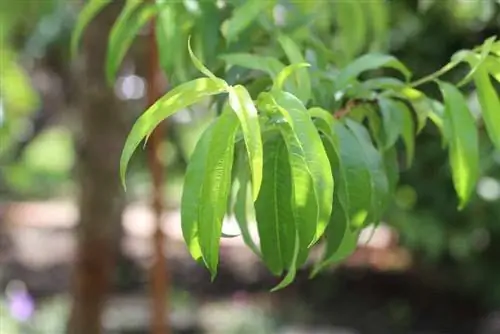
Peach trees that have been grown in containers are often affected by shotgun disease. Then small, dark spots appear on the leaves that look as if they had been shot at. This is a fungal disease that should be treated immediately. Because it can also spread to the fruits and the entire tree. Therefore, in such a case, you should immediately act as follows:
- remove all affected leaves
- also the affected fruits
- Cut back branches if necessary
- dispose of all removed plant parts in residual waste
- do not dispose of in a compost bin
- Use fungicides
- Use a commercially available copper preparation in the fall
- has a preventive effect
- Change the substrate and wash and disinfect the pot well
- Mushrooms also like to settle in the ground
Shotgun disease can spread very well in a humid environment. It is therefore important that the peach tree in the pot has a protected location. A covered balcony or terrace can also have a preventive effect here.
Pests
The most common pest infestations are aphids, scale insects and spider mites. While aphids usually appear on the buds and new leaves in spring, spider mites and scale insects like to spread on the plant in winter quarters. All pests can be controlled by rinsing and spraying with soapy water.

